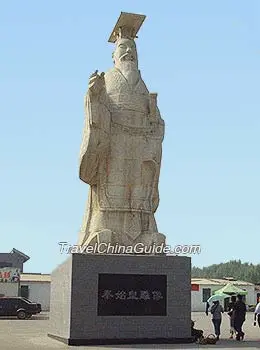Mystery about Emperor Qin Shi Huang
Controversial Origins
For a long period time, people have been puzzled by the origin of Emperor Qin Shi Huang. According to the Historical Book, the natural father of the first emperor was Lu Buwei, not King Zhuangxiang of Qin. The explanation for this is that by the time Zhao Ji, the concubine of Lu Buwei, was sent as a gift to Zi Chu (later King Zhuangxiang of Qin), she was already pregnant by Lu. After one year's marriage to King Zhuangxiang of Qin, she gave birth to Qin Shi Huang. However, some scholars point out that the duration of the pregnancy lasting a full year was irregular based on modern medicine. To say the emperor was an illegitimate child is obviously a slander to him.
Handsome or Disfigured
 |
| Statue of Qin Shi Huang |
About the appearance of the Qin Shi Huang, people have two conflicting opinions. Some say he was tall and handsome while others hold that he was short and disfigured. The description of his features can be found in the Book of History. But since the book was written in classical languages during the Western Han Dynasty (206 BC-24 AD), there are disagreements based on the difference of interpretation of modern people. One group thinks the emperor had big eyes, a high nose, a loud voice and a spirited quality in action. Walking erect and confident, he was a real Apollo. While in the opinion of others, represented by Guo Moruo, a Chinese author, historian, and archaeologist, Qin Shi Huang had a saddle nose, protruding eyeballs and the howl of a jackal. He was pigeon-breasted and suffered from tracheitis and rickets.
However, many people cannot accept that the first emperor was such a monster and believe this only vilifies the emperor. In the Qin state, the most soldierly prince was chosen to succeed to the throne instead of the eldest. Therefore, a disfigured and handicapped boy would not be appointed as the crown price. In addition, Zhao Ji, the mother of Qin Shi Huang, was a well-known beauty. The father of the emperor, King Zhuangxiang of Qin, inheriting a royal lineage, was probably endowed with an excellent genetic code. So Qin Shi Huang, should have inherited good characteristics from his parents. Therefore, the features of the emperor were more likely to have been fine and at least not ugly.![]() Were the remains of Qin Shi Huang preserved intact?
Were the remains of Qin Shi Huang preserved intact?
 |
| Qinshihuang's Mausoleum |
But many other experts hold a different view. They believe only the emperor's skeleton remains in the mausoleum, even though the underground palace was not ransacked, because it was not easy to preserve the dead body in hot summer. According to the Historical Book, the body had already begun to putrefy after being transported a short distance. To disguise the bad smell to avoid the news of the emperor's sudden death to be known (as this would cause a great disorder under heaven), Zhao Gao and Hu Hai had servants place baskets of abalone. After about 50 days traveling on a bumpy road, the body of the first emperor was probably not intact. Therefore, if the mausoleum was opened today, we would only find the bones of the emperor and his real appearance is forever a mystery.![]() Why the Emperor Qin Shi Huang did not determine the empress?
Why the Emperor Qin Shi Huang did not determine the empress?
It is a fact that Qin Shi Huang was the only emperor in Chinese history that did not have an empress. Is it because he had too many concubines than he could choose? Or his mother's bad behavior made him hatred of women? Or there was no woman qualified enough to be his empress? There were dozens of guesses.![]() What did Qin Shi Huang die from?
What did Qin Shi Huang die from?
Like his birth, the death of Qin Shi Huang is also a mystery. His sudden death gave people a lot of space to imagine. Some say he died of poisoning from the elixirs. Some believe that he died from overwork. And in other's view, he died of murder. Who is correct? There is no final conclusion.![]() Where was he buried?
Where was he buried?
Actually, apart from the tomb in Qin Shi Huang Mausoleum, some people believe that Emperor Qin Shi Huang was buried where he passed away, which is now somewhere in Xingtai City, Hebei Province. Because at that time, his attendants were not able to preserve his body or move it back to capital city Xianyang.![]() You may like:
You may like:
9 Mysteries of Qin Shi Huang Tomb You May Want to Know
Qin Shi Huang Facts: 10 Things to Know about the First Emperor of China